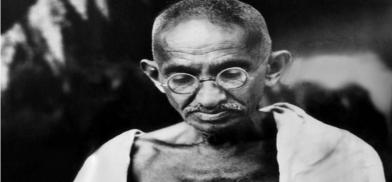Mahatma Gandhi and India@75: Fabricated news making a mockery of Gandhi's quest for truth
Paradoxically, but not surprisingly, over the last six decades, the collective commitment to truth as a principle to be adhered to with Gandhian conviction has been diluted progressively, writes Cmde C Uday Bhaskar (retd) for South Asia Monitor

This Gandhi Jayanti, October 2, is special, for it is the run-up to India@75 in August 2022, when the world’s largest democracy will celebrate 75 years of freedom from colonial yoke. This transition was enabled in very large measure by one man - Mohandas Karamchand Gandhi – who is also venerated as the apostle of non-violence and the "Father of the Nation".
Affectionately referred to as ‘Bapu’ (father), the pride of place once accorded to Gandhiji in the long drawn out Indian freedom struggle is now being questioned in the intense socio-religious and political churn that is now taking place in India. Bapu’s plea for inter-faith harmony that led to his assassination in January 1948 has now been overshadowed by the politics of discord and many of the principles dear to him have been either jettisoned or reduced to annual rhetorical lip service.
Non-violence and truth are two core elements of Gandhian thought and the latter was seen as the path to God. Writing in January 1927, Gandhiji noted: “Devotion to this Truth is the sole justification for our existence. All our activities should be centered in Truth. Truth should be the very breath of our life.”
In January 1950 when India became a Republic with its own Constitution, the national motto adopted was ‘satyam-eva jayate’ ( truth alone triumphs) which is a line taken from an ancient Upanishad. Paradoxically, but not surprisingly, over the last six decades, the collective commitment to truth as a principle to be adhered to with Gandhian conviction has been diluted progressively. This phenomenon is perhaps a reflection of the complex evolution of human sensibility, shaped as it has been by the temporal-technological continuum through the eons.
Fabricated adulation
However, in recent times the fidelity to truth and facts has been distorted in myriad ways and communication cum cyber technological advances have introduced the concept of ‘fake news’ or fabricated narratives that are packaged as reality. This is now becoming a global phenomenon and the line between truth and embroidered truth/fact, often deliberately manipulated, is difficult to distinguish in the proliferation of information - that is a continuous cyber cascade.
The more recent high visibility incident pertains to Prime Minister Narendra Modi’s end September visit to the USA and the manner in which this has been distorted. A screenshot of what seemed to look like the front page of the New York Times had an image of Mr. Modi and the accompanying text read: “Last, Best Hope of Earth” and “World’s most loved and most powerful leader is here to bless us.”
This adulatory reference to the Indian Prime Minister was actively shared on social media by the cyber ecosystem that actively supports the Modi-BJP combine and this included a National General Secretary of the Bharatiya Janata Party Youth Wing.
In what can only be termed as an avoidable embarrassment to Modi, the New York Times (NYT) took to Twitter to clarify that this image was fake and was not carried by the prestigious daily. The tweet from NYTimes Communications @NYTimesPR read:
This is a completely fabricated image, one of many in circulation featuring Prime Minister Modi. All of our factual reporting on Narendra Modi can be found at: https://nytimes.com/topic/person/narendra-modi
This kind of fabricated adulation for the Indian Prime Minister in any forum – domestic or international - is deplorable and to be rejected. One would have expected the PMO to insulate the Prime Minister from such clumsy and false fawning but it is intriguing and disappointing that there has been no such distancing or pushback by Delhi apropos the false claim about the NYT story, let alone admonishing the unctuous perpetrators.
Information pollution
But such fake news has become par for the course in some sections of the Indian media – that is referred to as ‘godi media’ (lapdog media) – and this has also distorted security issues. Even as the NYT fiasco cast aspersions on the credibility of some Indian cyberspace activists – a French TV channel exposed the false news pattern in relation to a purported airstrike in the Panjshir Valley of Afghanistan.
What was emotively reported as an airstrike by the Pakistan Air Force by some major TV channels turned out to be a fabricated clip from a video game. The brief conversation between the French anchor and a fact-checker raised questions about the credibility of the Indian media and was a case of more egg on the face.
Both these incidents are the tip of the malignant iceberg of information falsehood and fake news that is floating in the Indian information ecosystem, particularly in the unregulated world of social media, and akin to environmental pollution. There is a cynical acceptance that Delhi is now among the most polluted cities in the world – both by way of its air quality and the state of its once vibrant river – the Yamuna. Add to this the proliferation of fake news, embroidered facts, and information pollution, and sadly, India@75 has now stood Gandhiji, and his eternal quest for truth, on his head.
(The writer is a former Indian Navy officer and Director, SPS. The views expressed are personal).









Post a Comment